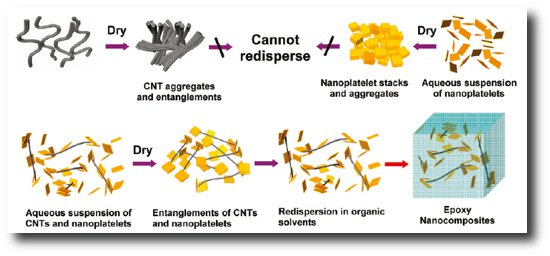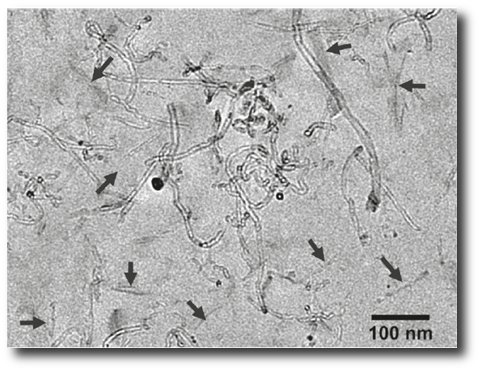Texas A&M University

Student Login
Epoxy/CNT/α-ZrP Nanocomposite
Single walled carbon nanotubes (SWNTs) have been described as the most perfect form of fiber that scientists can hope to make. SWNTs are known to possess extremely high strength and modulus due to its strong C-C bonds and mostly defect-free crystalline structure. It is not surprising that SWNTs are considered the perfect reinforcing filler for a composite material. Multi-walled carbon nanotubes (MWNTs) are weaker cousins of SWNTs but still a very attractive candidate for reinforcement of nanocomposite. Our method of exfoliating nanotubes using nanoplatelets enables us to disperse nanotubes in organic solvents. The exfoliated nanotubes can be mixed with epoxy monomer in solution, followed by removal of solvent, leaving the nanotubes and nanoplatelets dispersed in the epoxy monomer. The epoxy is subsequently cured and a fully dispersed epoxy/CNT/α-ZrP nanocomposite is obtained. This preparation method is summarized in the schematic illustration below. Nanotubes are dispersed at the individual nanotube level through the use of this method, as shown in the TEM image.

|

|
Comparing this class of nanocomposites with the earlier epoxy/α-ZrP nanocomposites, we found that the addition of MWNTs significantly enhanced the mechanical properties of the material. In particular, the epoxy hybrid nanocomposite containing 0.4 wt % of MWNTs and 2.0 wt % of exfoliated α-ZrP nanoplatelets exhibited a 41% increase in Young’s modulus, 55% increase in tensile strength, and 24% increase in elongation at break. The simultaneous improvement in modulus, strength and ductility of a nanocomposite is rarely reported and it is of great interest to be able to find a reinforcing agent that can do this. It appears that the nanotubes play an important role here, although the underlying mechanism is not clearly understood and remains to be explored.
Related Publications
Dazhi Sun, Chien-Chia Chu, and Hung-Jue Sue, “Simple Approach for Preparation of Epoxy Hybrid Nanocomposites Based on Carbon Nanotubes and a Model Clay” Chem. Mater. 2010, 22, 3773–3778.
| <<Back | Nanomaterials | PMMA/ZnO Nanocomposites>> |